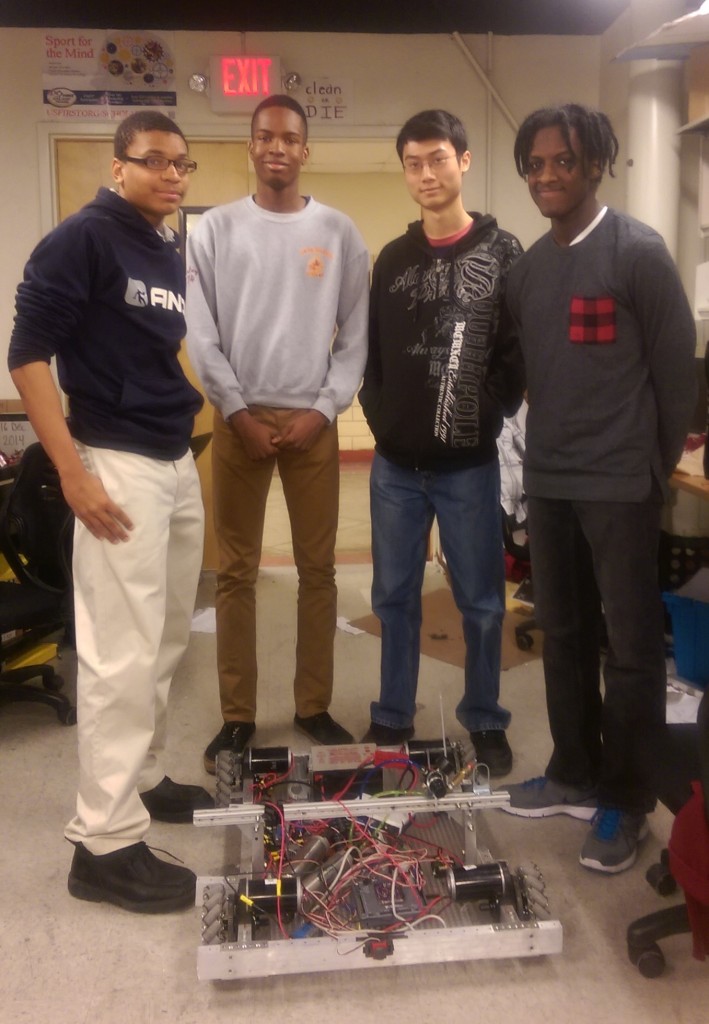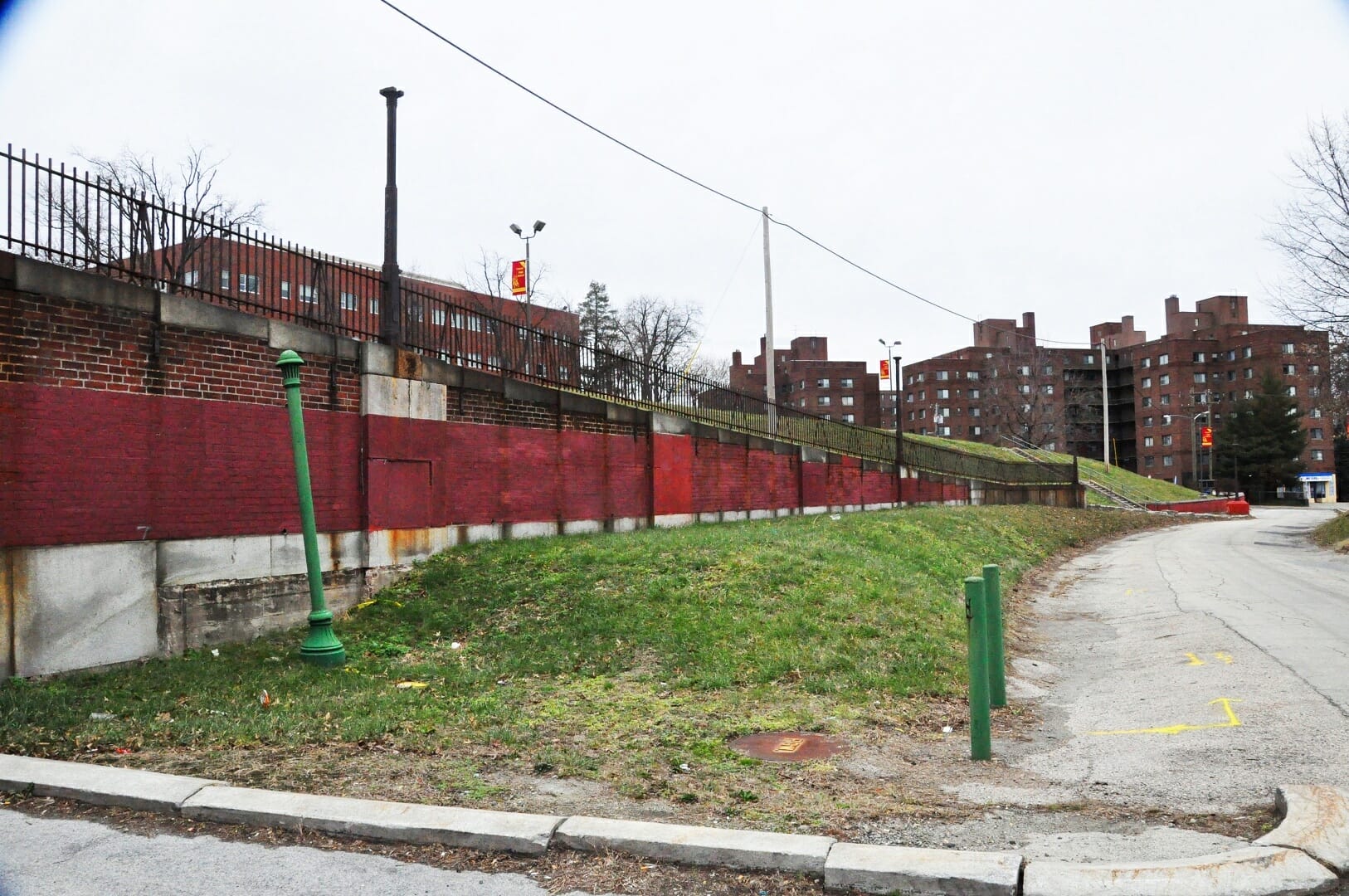Anyone who thinks robotics is dull better not go near Central’s RoboLancers team. You might catch what they have–boundless enthusiasm, camaraderie, style, and smarts for miles.
With four dynamic leaders and an expert marketing chief, the 30-or-so member team is battling once again to qualify for the FIRST World Championship in St. Louis next month–and an even higher honor that speaks to competitors’ character.
The RoboLancers main competitions are via the non-profit group FIRST–For Inspiration and Recognition of Science and Technology– which was founded in 1989 “to inspire young people to be science and technology leaders.” It has a reach of more than 400,000 students on 38,000-plus teams world-wide.
FIRST sponsors annual competitions across all student age groups. The RoboLancers Above, from left: Kamal Carter, Stanley Umeweni, Brian Cheng and Armond Smith. Below, Maria Shayegan
compete in the FIRST Tech Challenge and the FIRST Robotics Competition.
Once the new year’s challenge is announced in early January, competitors have six weeks to design, build, and program an approximately 120-pound robot from a common kit of parts provided by FIRST to perform certain tasks set out by FIRST. Robots then compete at two or three regional events in a three-team alliance against another three-team alliance.
This year’s competition is “Recycle Rush,” a game in which robots score points by stacking totes on scoring platforms, capping those stacks with recycling containers, and properly disposing of swimming-pool noodles, representing litter. (Click here to view the demo) The idea is to have teams think about automation, such as the way robots at a retail warehouse might move and stack products. The student teams have drivers who maneuver their robots in a pit for two minutes to get their robots to perform as efficiently as possible. There is also a challenge in which teams must program their robots to perform a task fully automated, ie no human driver, for 15 seconds.
Working with two unfamiliar teams and their robots in this alliance format is quite the challenge. Robots bump into each other, parts fall off, etc. Plus, the games can allow for some mischief. This year, alliances are allowed to litter their opponents’ stacking area with pool noodles.
Add to the atmosphere cheering teammates and fans in the stands plus loud music and you have quite a scene.
“It feels like a basketball game, it’s so pumped,” said the team president, senior Stanley Umeweni (274).
At one of this year’s FTC competitions on March 14 at Springside High School in Chestnut Hill, the RoboLancers and “321,” (so named because it was the 321st robot team registered with FIRST) advanced to the semifinals for the first time in the team’s 16-year history. This weekend 321 is headed for competition at Upper Darby high School, hopefully helping the Lancers continue stacking enough points to qualify for St. Louis April 22-25.
Stanley has been to that mountaintop–the St. Louis Rams’ Edward Jones Dome–once before, when he was a sophomore, and he wants to get back there very much.
“Seeing that whole thing filled up by kids, it’s crazy to be there,” he said. “Like how NASCAR has pits for drivers. Everyone here is interested in the same thing I’m interested in and I’m not being called a nerd for that. That’s really cool.”
There are two ways to qualify for the world championship–through a regional championship and through winning FIRST’s highest honor, The Chairman’s Award. The chairman’s award honors the team and its mentors that best demonstrate these values: building and sustaining a team; helping others; spreading the message of FIRST; mentoring; and ‘gracious professionalism’ and ‘cooperation.’
No two robots are built alike and no two teams operate alike. The degree of teacher/mentor input is basically at the discretion of each team.
With the RoboLancers, “Students do, mentors help out,” Stanley said.
Central’s teams is divided into three sections: mechanical, electrical and programming. Kamal Carter (274) leads the mechanical team, Maria Shayegan (274), who started off “knowing nothing,” leads the electrical team and Armond Smith (274) is lead programmer .
Maria said her physics class helped a bit to understand how everything works and she wants to continue focusing on physics or math in college.
Armond also knew little about his area of focus when he began with the team and is basically self taught through a lot of reading.
Central teachers/team coaches Michael Johnson and Darcel Bonner provide guidance for the students through all the long evenings of building and testing, the competitions and even weekend seminars and training the students are eager to attend.
Maintenance staff close the Central building at 8:30 on school nights and “we’re leaving at 8:15, 8:20” every night during robot-building season, an exasperated but proud Miss Bonner said.
In true Central form, alumni also give back with their time, expertise and money. For example, Joseph Carlini’s (239) engineering services company, which has 600 employees across the U.S. and contracts with the Defense Department, is one of the RoboLancers’ many sponsors.
Building robots and transporting them to competitions, as you can imagine, is expensive. “For FRC it costs $5,000 just to compete for the two district events, then robot-wise we probably spend $10,000 for materials alone,” mechanical lead Kamal said.
And to get sponsors you have to sell what you do. Marketing leader Brian Cheng (274) has the team covered, handling the team’s website, plus accounts for Facebook, Twitter, Flikr, Instagram and YouTube.
“These guys build a very good robot and that’s great and all but how are you going to promote that?” Brian said. “We need to shout it to the world: Hey, we built a great robot. Marketing also tries to find sponsors and grants for the team to sustain itself.”
As much as they promote themselves, the RoboLancers are more about promoting the coolness of STEM–Science, Technology, Engineering and Math education–to kids of all neighborhoods and schools all around the city. Stanley is the event coordinator for the student-organized Philly Robotics Expo April 20 at the University of Pennsylvania, which will feature workshops to interest kids of all ages in robotics.
“My biggest thing is outreach,” said Stanley, who speaks so excitedly it can be hard to keep up. “We host scrimmages so that kids can come and see the actual games so that when they go to competitions they do better.”
Yes, it’s competition, but it’s also about uplifting fellow students in these times of austerity and inequality. If some team loses a part during a competition and the Lancers have a spare, the Lancers gladly hand it over. The Lancers also know they are quite blessed to have a dedicated robotics room in the basement of their school, thanks to Joan Spain, wife of alumus Bernie Spain (198). So when another Philly school’s team needed some space to work on its robot this year the Lancers invited them to come use theirs.
The seniors on Central’s team are also ensuring that as much of their knowledge as possible stays with the remaining members when they exit those Central doors.
Lead programmer Armond said electrical and mechanical knowledge is a lot easier to be shared “because you can physically see what you’re doing; you have your old robots from years past. You can see how each part intertwines with the next part.”
Programming, on the other hand, can be a lot more abstract. And Armond doesn’t want future teams to have to use up a lot of their time relearning and retesting things of previous generations. “I’m trying to have a basis for all the years’ coming programmers, all the generations down the line so that they actually have somewhere to start.”





